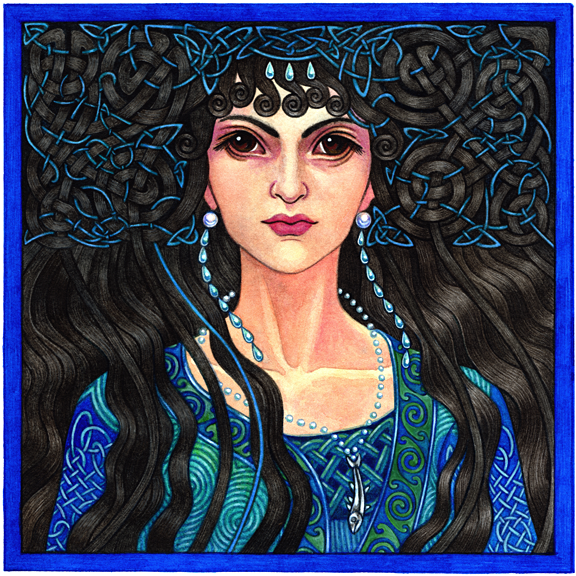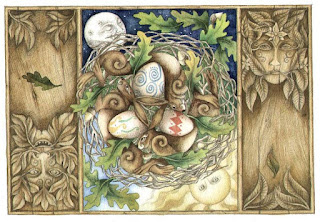 |
| 'Ostara', by Helen Nelson Reed |
Going back to the Wheel of the Year posts, here's a (belated) quotes+pics post about Eostre, the Spring equinox, also called Easter, Meán Earraigh and Alban Eilir. I personally don't really celebrate Eostre and stick to enjoying a week-full of holidays, eating chocolate eggs and looking at nature (which could actually qualify as 'celebrating Eostre', though xD), but I'm always interested in studying mythology and neopagan feasts, so here it is :)
-Sources and copyright: Sources can be found at the end of the post and images and quotes are credited and used for non-profit aims. Artists, if you don't want your artwork to feature here, please let me know! The authors of some of these pics remain unknown to me. If you know the authorship, or if you are the author, please let me know, and I will credit them.
-Pagan origin and characteristics:
"Meán Earraigh marks the Spring equinox, when night and day are of equal length and spring officially begins. Birds begin their nesting and egg-laying, and eggs - symbolic of rebirth, fertility, and immortality- are tossed into fresh furrows or eaten by ploughpeople. They are also carried by those engaged in spring planting." (A Druid's Herbal for the Sacred Earth Year, Ellen Evert Hopman)
Ostara, by Christopher Bell, source
|
"Ostara, (...) also called Lady Day, is a Pagan holiday, celebrated every year on the spring equinox, usually March 21. Saxons had a festival every year for their spring and fertility goddess, Eostre, involving variations of many traditions we use today. (...) Eventually, the christians adapted the word 'Easter', and some of the traditions. The 'Easter bunny' comes from an old sign of fertility, the rabbit. (...) Chicks as well, which emerge from their shells (...). Both animals were sacred to goddesses of Spring annd fertility, and were often honoured around the spring equinox. Eggs are also symbols of fertility (...) in Old Europe, eggs were decorated and given as gifts, as wishings of abundance in food and prosperity." (Source)
"Most of what people commonly associate with Easter is pagan in origin (...) Pagan roots of Easter lie in celebrating the spring equinox, for millennia an important holiday in many religions. Celebrating the beginning of spring may be among the oldest holidays in human culture. Occurring every year on March 20, 21, or 22, the spring equinox is the end of winter and beginning of spring. Biologically and culturally, it represents for northern climates the end of a “dead” season and the rebirth of life, as well as the importance of fertility and reproduction." (Source)
 |
| Eostre by Wenndy Andrew |
More about the paralell elements of the polytheistic and monotheistic beliefs and celebrations of the Spring Equinox here. Many people don't seem to know that "a focus of spring religious festivals was a god whose own death and rebirth symbolized the death and rebirth of life during this time of the year", which is another reason why I think that all human religious are the same one with variations depending on the culture of origin - and this is why I find it it utterly ridiculous to fight over which religion is 'the real one' (and among other things, this is also why I am a religious-book-atheist - I don't believe in any deity described by humans in their books and mythologies as 'the real one' -, but a pure agnostic regarding the possibility of the existence of a divine being, because I think that I ca hardly claim the existence or non-existence of such a thing without empirical evidence).
 |
| Pagan holidays turned Christian: Easter. The origin of Easter is Germanic, though, the Celts didn't celebrate it, for them Spring begins with Imbolc. |
- The Goddesses of the Spring Equinox:
-Ostara/Eostre, Germanic Spring and Dawn Goddess:
This Germanic Goddess (Old English: 'Ēastre', Old High German: '*Ôstara', source), a goddess of dawn and the sky, and a 'bringer of light' (related to the idea of the Sun Goddess), is the namesake of the festival of 'Easter'.
"Pagan Anglo-Saxons had held feasts in Eostre's honor, but that this tradition had died out by his time, replaced by the Christian Paschal month" (Source)
 |
| Goddess Eostre/Ostara by Johannes Gehrts |
"Ostara, the Spring Equinox, derives it name from the Goddess Eostre. The Earth is now clearly awakened from her slumber. The day and night are equal but the light is gaining (...) This is a time of feasting and celebration. There is a sense of energy and promise personified by the beauty, strength, and freedom of the young virgin Goddess. This is when the clover appears in the fields, a symbol of the rebirth of the Maiden aspect of the Triple Goddess. Significant symbols are the lamb, the hare, and the egg, all universal archetypes of fertility, renewal, and new life (...)" (Source)
 |
| Eostre (author unknown to me) |
-About the term 'virgin': About this excerpt, I would like to note than in this context of 'the Goddess' the term 'virgin' simply means a 'young woman' and has empowering connotations of 'strength', 'freedom' and 'power' (the root of the word is actually the same as the one in 'virility', but thanks to Patriarchy men got the 'strength', 'power' and 'freedom' connotations while women were stuck with 'modest', 'naïve', 'inexperienced' and 'sexually untouched by men'). Here 'virgin' has nothing to do with the goddess's sexuality or sex life (as in 'sexually inexperienced' or 'untouched (by men)'). The later patriarchal connotations, deeply influenced by monotheistic religions such as Christianity (and most ancient and polytheistic societies were generally quite patriarchal and male-dominated as well, even though the women fared better in their myths and religions), are full of oppression: sexism, misogyny, double standards and heteronormativity. The Goddess is both 'virgin' and 'mother', because she can create life without the intervention of males, and she is both 'virgin' and 'lover' because she can have a free sexuality without oppressive notions of 'purity' or 'modesty'.
-Boann, Irish cow goddess: Associated with fertility and healing (water,cows), creativity, inspiration and wisdom (water, the Salmon of Knowledge, source) and astronomy.
 |
| Boann by ThaliaTook |
"The female aspect of this festival [Meán Éarraigh, the Neopagan Celtic Spring equinox] is personified by Boand (...), who is sometimes equated with the River Boyne. (...) Boand is known as "She of the White Cows". It is worthwhile to remember that Brighid was raised on the milk of a white cow with red ears. Otherwordly beasts such as dogs and cows are generally described with this colouring. Sacred kine are often said to emerge from lakes; water is the entrance to the Otherworld. If you visit the River Boyne, you will find that she is quite maternal, flowing gently (...) like a placid milk cow." (A Druid's Herbal for the Sacred Earth Year, Ellen Evert Hopman)
-Religion-free spiritual aspects of Eostre in Neodruidism:
 |
| 'Moonlit Hare' by Amanda Clark |
"Alban Eilir (light of the earth), the vernal equinox, around March 21
Physically: The time of sowing most seeds and first growth
Magically: The sun gaining in strength over the night; the greening of the earth" (The Path of Druidry, Penny Billington)
"Light overtakes the dark. Rebirth of life. Contemplate new beginnings and fresh ideas. Serious mediation on your hopes and dreams for the coming year. Solar festival of fire, light, and fertility." (Source)
- Sources:
-The Path of Druidry by Penny Billington
-Ravens Wyrd - Equinox
-Ostara: Anglosaxon and Germanic vs Christian
-The Pagan elements of Easter
-Pagan holidays turned Christian
-Eostre (Wikipedia)
-Boann (Wikipedia)
-Boann - The Somathread

Just remmember that Ostara/ Easter has nothing to do with Celts...There's no historical celtic celebration at Spring Equinox.
ReplyDeleteUm, this post already makes it clear that I'm well aware that Ostara/Easter is of Germanic origins, though?? Yep, I already knew that the original Celtic festivities in the Neopagan Wheel of the Year are only Samhain, Imbolc, Beltaine and Lughnasadh, and that the Equinox and Solstice celebrations were not a part of the Celtic seasonal calendar.
Delete*However*, also remember that Neopaganism and the way people currently choose to celebrate the Wheel can also include Celtic parallels, elements and versions of the Equinox and Solstice festivities, and that is something that this post is also referring to. Meán Éarraigh/Alban Eilir is the *Neo*pagan Celtic version of Ostara.